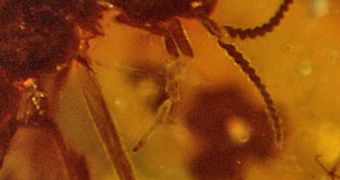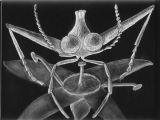Paleontologists have recently made an important discovery in the state of Myanmar, when they have come acorss the fossilized remains of a “unicorn fly.” The insect was, apparently, extremely well endowed for steering clear of predators. It featured a large, horn-like structure at the top of its head that was topped by three small, fully functional eyes. This brought the grand total to an amazing five eyes, which allowed it to view its surroundings with extreme accuracy, and to identify looming predators regardless of their position, LiveScience reports.
The recently found specimen was preserved in a small piece of Burmese amber, which was discovered in a Hukawng Valley mine. The investigations of the small formation revealed that, in addition to the three peculiar eyes, the fly was also endowed with regular, compound eyes that offered it a nearly 360-degree-wide view of what was going on around it. According to the dating study, the piece of amber that trapped the unicorn fly was formed some 97 million to 110 million years ago. The insect has recently been dubbed Cascoplecia insolitis.
Scientists studying it say that the specimen could give them more clues about ancient ecosystems, and the animals that lived in them. This could lead to a better understanding of the period, when a large number of peculiar organisms lived at the same time as dinosaurs and other large reptiles. “No other insect ever discovered has a horn like that, and there's no animal at all with a horn that has eyes on top,” Oregon State University (OSU) Professor of Zoology George Poinar, Jr. says. He is also the author of a new study detailing the finds, published in the latest issue of the journal Cretaceous Research.
“This was near the end of the Early Cretaceous when a lot of strange evolutionary adaptations were going on. Its specialized horn and eyes must have given this insect an advantage on very tiny flowers, but didn't serve as well when larger flowers evolved. So it went extinct. This 'unicorn' fly was one of the oddities of the Cretaceous world and was obviously an evolutionary dead end,” Poinar adds. “It was probably a docile little creature that fed on the pollen and nectar of tiny tropical flowers,” the expert shares.

 14 DAY TRIAL //
14 DAY TRIAL // 
